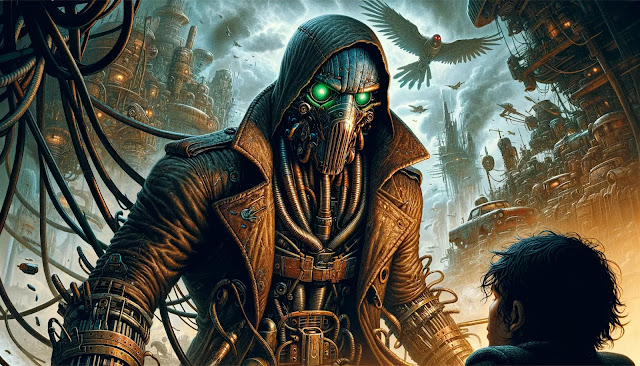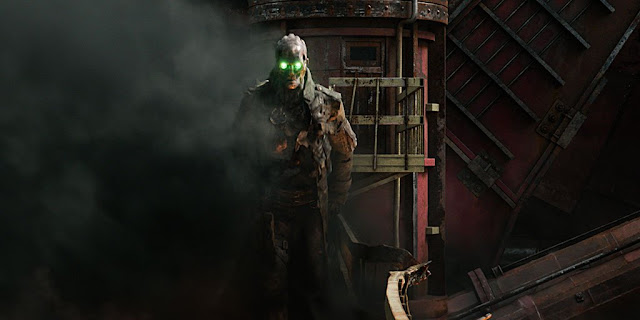Hester Shaw emerges as a central figure whose personal evolution is as turbulent and dynamic as the world she inhabits.
This essay seeks to explore Hester's journey from a revenge-driven outcast scarred by past traumas in "Mortal Engines," through her complex relationships and moral dilemmas in "Predator's Gold" and "Infernal Devices," to her quest for redemption in "A Darkling Plain."
Her development is not just a personal odyssey but a reflection of the thematic depth of the series, touching on resilience, redemption, and the transformative power of love and forgiveness.

Driven by Vengeance
Hester Shaw is first introduced as a disfigured, mysterious young woman with a singular focus: to avenge the death of her mother and her own disfigurement at the hands of Thaddeus Valentine, a revered historian of the predatory city of London.
Unlikely Alliances and Personal Growth
Hester's journey takes a pivotal turn when she encounters Tom Natsworthy, a lowly apprentice historian from London, who becomes an unlikely companion after they are both expelled from the city. This partnership, born out of necessity, gradually evolves into a profound bond that challenges and transforms Hester.
Confrontation and Transformation
The climax of "Mortal Engines" sees Hester facing her nemesis, Thaddeus Valentine, in a confrontation that is as much about confronting her past as it is about seeking justice. This moment is crucial in Hester's arc, serving as a catalyst for her transformation.
Hester Shaw's Evolution
By the end of "Mortal Engines," Hester Shaw emerges as a significantly changed character. Her evolution from a vengeance-driven loner to a character capable of love, trust, and sacrifice underscores the novel's thematic exploration of redemption, resilience, and the human capacity for change.
Predator's Gold
In "Predator's Gold," the second installment of the "Mortal Engines Quartet," Philip Reeve continues the saga of Hester Shaw, a character whose depth and complexity are further explored against a backdrop of steampunk adventure and societal upheaval. This essay examines Hester Shaw's character development in "Predator's Gold," highlighting how her internal struggles, relationships, and actions contribute to her evolution and underscore the novel's thematic concerns.Hester Shaw's Emotional Turmoil
Hester's journey in "Predator's Gold" is characterized by her battle with deep-seated insecurities and jealousy, primarily stemming from her relationship with Tom Natsworthy and their encounter with Freya Rasmussen, the leader of Anchorage. Hester's grotesque disfigurement, a constant source of personal angst, feeds her insecurity, especially in the presence of Freya, whom she views as a rival for Tom's affection.
Actions Driven by Fear and Love
Hester's actions throughout "Predator's Gold" are often driven by a convoluted mix of fear and love. A pivotal moment illustrating this is her confrontation with Freya, where Hester's threats are motivated by a desperate attempt to protect her relationship with Tom. This scene highlights Hester's willingness to cross moral boundaries, underpinned by her fear of losing Tom.
Moral Ambiguity and Consequences
The novel does not shy away from presenting Hester's morally questionable decisions, which serve as a critical aspect of her character arc. Hester's contemplation of abandoning Anchorage to its fate, driven by a survival instinct, poses significant ethical dilemmas.
Confrontation, Growth, and Redemption
Hester's evolution reaches a turning point as she is forced to confront the consequences of her actions. Her journey through adversity, both external and internal, catalyzes a reflective process, leading to acknowledgment and, eventually, growth.
Infernal Devices
In "Infernal Devices," the third novel of the "Mortal Engines Quartet," Hester Shaw's character arc continues to evolve amidst the backdrop of a world still rife with conflict and transformation. This section of her journey introduces new dimensions to her character, particularly focusing on her roles as a mother and a partner, while delving deeper into her internal conflicts and the consequences of past actions. Hester's relationship with her daughter Wren, her ongoing struggle with her identity and self-worth, and the choices she makes in the face of new challenges illustrate significant growth and depth in her character.The Introduction of Motherhood
The novel introduces Hester as a mother to Wren, adding a complex layer to her character. Hester's fierce protectiveness and deep love for Wren are juxtaposed with her fears of inadequacy as a parent.
Hester's journey in "Infernal Devices" is marked by her confrontation with her past. The return of old enemies and the revelation of secrets force Hester to reckon with the consequences of her earlier actions.
The Struggle for Identity and Redemption
Throughout "Infernal Devices," Hester's struggle with her identity and her quest for redemption are central themes. Her relationship with Tom, strained by their past and by the secrets they keep, serves as a mirror reflecting her internal battles. Hester's actions, driven by a complex mix of love, fear, and desperation, further complicate her quest for redemption.
Choices and Consequences
The climax of "Infernal Devices" brings Hester's character arc to a critical juncture. Faced with the ultimate choice between continuing her cycle of violence or embracing a path towards peace and reconciliation, Hester's decisions have far-reaching implications.
A Darkling Plain: The Culmination of Hester Shaw's Journey
In "A Darkling Plain," the final installment of the "Mortal Engines Quartet," Philip Reeve brings the epic saga of Hester Shaw to a poignant and dramatic conclusion. Throughout the series, Hester has evolved from a vengeful, solitary figure into a complex character grappling with issues of love, redemption, and identity.The Quest for Redemption
Hester Shaw's narrative in "A Darkling Plain" is heavily marked by her search for redemption. Bearing the weight of her past actions, Hester seeks to reconcile her violent deeds with her desire for a peaceful future. This quest is illustrated through her efforts to protect her family and mend the rifts her actions have caused.
The Complexity of Relationships
The novel delves deeply into the intricacies of Hester's relationships, particularly with Tom Natsworthy. Their bond, tested by time, betrayal, and the scars of past battles, faces its ultimate trial. Reeve masterfully explores the nuances of love and forgiveness through their interactions, providing a raw and honest look at the challenges they face together.
Actions and Legacy
In "A Darkling Plain," Hester's actions are driven by a combination of desperation and hope. One of the novel's most compelling examples of this is her confrontation with the Stalker Fang, a pivotal moment that encapsulates her willingness to sacrifice everything for the sake of a better world.
The Final Resolution
The conclusion of Hester Shaw's story in "A Darkling Plain" is both tragic and fitting, providing a resolution that reflects the series' themes of change, loss, and the possibility of redemption. Hester's ultimate fate, intertwined with the fates of those she loves, underscores the series' exploration of the costs of war and the value of peace. It is a testament to her character's journey from darkness into a more nuanced understanding of herself and her place in the world.
-
The character arc of Hester Shaw across the "Mortal Engines Quartet" represents a meticulously crafted narrative of transformation, resilience, and redemption. Beginning as a character consumed by vengeance in "Mortal Engines," Hester evolves through experiences of love, loss, and moral quandaries, deeply explored in subsequent novels.

























